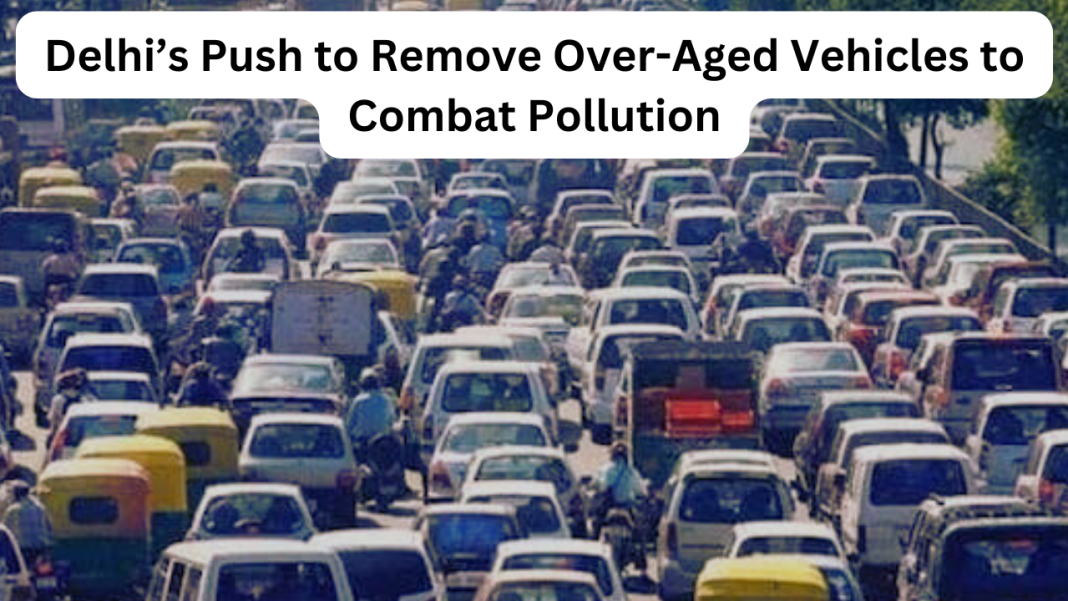Digital News Desk:
The Delhi government has intensified its efforts to tackle the severe pollution crisis by enforcing stricter regulations on vehicles that have exceeded their permissible age limits. This is part of a broader strategy aimed at reducing vehicular emissions, a significant contributor to air pollution in the National Capital Region (NCR).
New Policy for Ageing Vehicles
The Delhi government unveiled its “End-of-Life” policy for ageing vehicles as a response to mounting concerns about pollution and traffic congestion. The policy targets diesel vehicles older than 10 years and petrol vehicles older than 15 years. These vehicles, deemed high contributors to pollution due to outdated technology, are set to be phased out under this directive.
Instead of immediate confiscation, the government introduced fines to incentivize owners to voluntarily retire their old vehicles. Once seized, vehicles may be reclaimed only under the condition that they are either relocated outside Delhi or scrapped responsibly within six months. These stringent measures aim to ensure that outdated vehicles no longer contribute to Delhi’s alarming pollution levels.
Why Target Older Vehicles?
Delhi’s air pollution crisis has long been a critical issue. The city consistently ranks among the most polluted in the world, with vehicular emissions being a major contributing factor. Older vehicles, especially those running on diesel, are particularly harmful because they emit higher levels of pollutants like nitrogen oxides and particulate matter. Newer cars, in contrast, come with improved emissions standards, making them less polluting.
The government’s move is also seen as a part of a larger national effort under the Vehicle Scrappage Policy, which aims to encourage the purchase of cleaner, more fuel-efficient vehicles. By offering financial incentives for scrapping old vehicles, the policy promotes the adoption of newer, eco-friendly alternatives.

Enforcement and Compliance
The enforcement of this policy has led to the seizure of hundreds of old vehicles in Delhi, particularly those found parked on public roads. The Transport Department has ramped up efforts by issuing notices and impounding vehicles in violation of the age limits. Once impounded, vehicles cannot be released without a fine, and owners must sign an undertaking to ensure the vehicle’s relocation or scrappage.
Delhi’s initiative also allows for vehicles to be sold or registered in regions outside the NCR, where such stringent age limits do not apply. However, for those who wish to keep their vehicles within the NCR, there is an option to convert them to electric, although this is still a relatively uncommon practice.
Balancing Penalties and Incentives
The success of this policy hinges on striking a balance between penalties and incentives. While fines and vehicle seizures serve as deterrents, the government is also encouraging vehicle owners to voluntarily retire their ageing automobiles through scrappage programs. Many automakers have joined the effort by introducing attractive trade-in offers for those who wish to purchase new vehicles after scrapping their old ones.
These scrappage incentives are designed not only to take old vehicles off the roads but also to boost the automobile industry by encouraging the purchase of cleaner, greener vehicles. Under the Vehicle Scrappage Policy, citizens are offered benefits such as discounts on new vehicle purchases, waivers on registration fees, and tax rebates.
Impact on the Automotive Industry
Delhi’s decision has ripple effects on both the automotive industry and public transportation. As the capital pushes towards reducing its environmental footprint, automakers are expected to shift their focus towards producing vehicles that meet stricter emissions standards. The rise of electric vehicles (EVs) is anticipated, with more incentives likely to promote their adoption.
Moreover, as more ageing vehicles are phased out, public transportation options will also be evaluated for cleaner alternatives. Delhi has already begun investing in electric buses and encouraging the use of CNG-powered vehicles to reduce its overall carbon emissions.
Future Outlook
As pollution levels remain a pressing concern, the Delhi government’s policy on over-aged vehicles signals a strong commitment to environmental sustainability. The combination of stringent regulations, fines, and incentives is expected to gradually transform the city’s vehicular landscape. This initiative is part of a broader, long-term effort to improve Delhi’s air quality, reduce traffic congestion, and promote modern, sustainable transportation solutions.
The continued success of this policy will depend on enforcement, public compliance, and further collaboration between the government, vehicle owners, and the automotive industry. With more cities in India and around the world facing similar pollution challenges, Delhi’s approach may well become a model for others to follow in the fight against air pollution.
You May Also Read: Bahraich : 1 Killed, 30 Detained in Communal Clash During Durga Immersion in Uttar Pradesh








